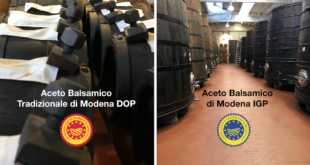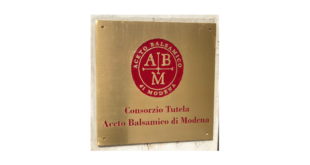Disciplinary for the production of Balsamic Vinegar IGP. To help the consumers to understand the importance of the regulation behind our food excellence, we decided to provide our readers with the entire document regulating the production and the designation of the Balsamic Vinegar of Modena IGP.
This is not an official translation and we decline any responsability for any mistake you may find. The official document is, in fact, in Italian.
MINISTRY OF AGRICULTURAL, FOOD AND FORESTRY POLICIES
ACETO BALSAMICO DI MODENA
Indicazione Geografica Protetta
Disciplinare di Produzione
Provision of the 8th of July 2009
Entering of the denomination <<Aceto Balsamico di Modena>> in the Register of protected designations of origin and protected geographical indications. (09A11837)
THE HEAD OF THE DEPARTMENT
of economic and rural development policies
Having regard to Council Regulation n. 510 of 20 March 2006 relative to the protection of geographical indications and denominations of origin of agricultural products and foodstuffs;
In accordance with Commission Regulation (CE) n. 583 of 3 July 2009, the denomination <<Aceto Balsamico di Modena>> referred to the category “Other” of attachment I – Aceto di-verso da Aceti di Vino- it is written which geographical indication protected in our register about protected origins (D.O.P.) and protected geographical indications (I.G.P.) provided by Art. 7, Paragraph 4, Regulation (CE) 510/2006;
Considered that there is still the need to publish on Gazzetta Ufficiale della Repubblica italiana the regulation about the production of protected geographical indication <<Aceto Balsamico di Modena>>, in order that all the dispositions in the aforementioned document are accessible for erga omnes information on the national territory;
Provides
the publication of the following attachments: production regulation and the summary of protected geographical indication <<Aceto Balsamico di Modena>>, established in the Community and registered under the Regulation (CE) n. 583 of 3 July 2009.
The manufacturers who intend to place on the market the denomination <<Aceto Balsamico di Modena>> can employ, at the presentation and designation of the product, the above-mentioned denomination and mention <<Indicazione Geografica Protetta>> only for those products in conformity to the Regulation (CE) n. 510/2006 and they are required to comply with all the conditions provided under the regulation in force.
Rome, 8th of July 2009
Head of Department: Nezzo
Attachment
Protected geographical indication
PRODUCTION REGULATION
BALSAMIC VINEGAR OF MODENA
Art. 1
Denomination
The protected geographical indication <<Aceto Balsamico di Modena>> is intended for a product that meets the conditions and the requirements established in this production regulation.
Art. 2
Characteristics for consumption
When Balsamic Vinegar of Modena is released for consumption, it shall conform to the following characteristics:
– limpidity: limpid and bright
– colour: dark brown
– smell: typical, persistent, intense and delicate, pleasantly acetic, with potential woody notes
– flavour: sweet and sour, balanced, pleasant, characteristics
– density at 20°C: not less than 1,06 for the processed production
– actual alcoholic strength: not more than 1,5% in volume
– minimum net dry extract: 30 g per liter
– minimum total acidity: 6%
– total sulphur dioxide: maximum 100 mg/l
– ash content: minimum 2,5 x 1000
– reducing sugars: minimum 110 g/l
The verification of the product’s analytic and organoleptic characteristics is made on each batch before the consumption by a panel of selected tasters under the responsibility of the control structure.
Art. 3
Production area
The production of Balsamic Vinegar of Modena shall be carried out on the administrative territory of Modena and Reggio Emilia.
Art. 4
Product’s origin
Each stage of the production process shall be controlled by the control structure, according to the systems fixed in the monitoring plan. At each phase inputs and outputs are documented. In this way the product’s traceability is guaranteed, but also through the registration in specific registers, which are managed by the control structure, of cadastral parcels on which the cultivation of grapes occurs, of viticulturists, of producers of must, elaborators, bottlers, as well as through the declaration to the control structure of the products’ quantities, but also of the packaged and labeled quantities. All physical and legal people, who are enrolled in the registers, will be subject of controls led by the control structure, according to what is determined by the production regulation and the relative control plan.
Art. 5
Elaboration method
Balsamic Vinegar of Modena is the product obtained by grapes musts, through specific and traditional technology. Grapes musts were obtained by the grapes coming from the following vines: Lambruschi, Sangiovese, Trebbiani, Albana, Ancellotta, Fortana, Montuni, partially fermented and/or heated and/or concentrated, with an addition of a percentage of vinegar aged at least 10 years, in order to confer the typical organoleptic features to the product, and with an addition of vinegar obtained by the acetification of at least 10% of wine only.
In order to ensure that Balsamic Vinegar of Modena acquires all the characteristics specified in Art.2, it is necessary that heated and/or concentrated must has the following features:
– minimum total acidity: 8 g/kg
– minimum net dry extract: 55 g/kg.
The percentage of heated and/or concentrated grape must shall not be inferior to 20% of the mass that has to be elaborated. The concentration is protracted until the initial mass of the must reaches a density that is not inferior to 1,240 at a temperature of 20°.
The phases, which shall take place compulsorily in the geographical area of origin, are the assembly of raw materials, elaboration, refinement and/or aging process in wood barrels. The addition of caramel for colorimetric stability is allowed up to a maximum of 2% of the finished product’s volume.
It is forbidden the addition of any other substance.
The elaboration of Balsamic Vinegar of Modena shall occur according to the usual method of acetification, using selected bacterical colonies, or the consolidated method of either superficial slow acetification or with wood chippings, followed by refinement. In any case, acetification and refinement occur in fine wood barrels, such as oak, in particular durmast, chestnut, mulberry and juniper, during a minimum period of sixty days, starting from the date when the assembly of raw materials for elaboration terminated.
According to the holder’s opinion, the product that obtained the minimum characteristics expected by this production regulation for consumption, is submitted to analytical and organoleptic analysis.
Art. 6
Links to geographical area
The reputation of Balsamic Vinegar of Modena, both on international and national markets, is well-known and largely demonstrated by the frequent employment in multiple recipes, starting from the consolidated presence on the Internet, to press and media. This reputation supports the consumer in recognizing immediately the uniqueness and authenticity of such product.
For some time now, Balsamic Vinegar of Modena represents Modena’s culture and history, and its worldwide reputation is undeniable. Its existence is strictly connected with knowledge, tradition and skills of the locals who realized an exclusive product, typical of that territory.
Balsamic Vinegar of Modena has become a source of income for different operators and an integral part of the culinary tradition, considering its recurrent presence in multiple regional recipes. Festivals and events have been following one another for years now and they go back to long-established past traditions, to which local producers participate to meet people, preserving in this way local traditions. As it’s a specific and peculiar product, Balsamic Vinegar of Modena has gained a great fame and notoriety worldwide, thanks to which consumers ideally link the story and tradition of the product to an image of gastronomic quality of the territory of the two Emilia Romagna’s provinces.
Art. 7
Control body
The controls will be carried out by a body in compliance with articles 10 and 11 of CE reg. n. 510/2006.
The control body is CSQA Certificazioni S.r.l. – Via San Gaetano n. 74 – 36016 Thiene (Vi-
cenza) – Italia – Tel. +39 0445/313011 – Fax +39 0445/313070 [email protected]
Art. 8
Designation and presentation
Passing the analytical and sensory exam is a binding condition in order to be able to commercialize the product with the denomination established in Art. 1.
The containers of Balsamic Vinegar of Modena shall be in glass, wood, ceramic or terracotta and with the following capacity: 0,250 l; 0,500 l; 0,750 l; 1 l; 2 l; 3 l o 5 l; and in single-dose plastic containers or composite materials, with a maximum capacity of 25 ml, on which shall be reported the same caption that appear on the bottles’ labels.
The glass, wood, ceramic or terracotta containers, with a minimum capacity of 5 liters, or plastic containers with a minimum capacity of 2 liters are however authorized in case the product is destined to professional use.
The designation of the denomination <<Aceto Balsamico di Modena>> shall be associated on the package with the caption <<Indicazione Geografica Protetta>> (Protected Geographical Indication), which shall be written in a clear and readable way, in full or short-form, in Italian and/or in the language of the country of destination.
It is forbidden any additional qualifying adjective to <<Aceto Balsamico di Modena>>, even in numeric form, which is different from those previously mentioned in the present regulation, including «extra», «fine», «chosen», «selected», «reserve», «superior», «classic» or similar ones.
Only the caption «aged» is allowed, with no other supplementary addition, in case aging was prolonged to a period that is not inferior to 3 years in barrels, drums or other wood containers.
Do you find it interesting the Disciplinary for the production of Balsamic Vinegar IGP?
disciplinare-aceto-balsamico-di-Modena-IGP
L-Originale Balsamic Vinegar of Modena: www.l-originale.com
Disciplinary for the production of Balsamic Vinegar IGP – Disciplinary for the production of Balsamic Vinegar IGP – Disciplinary for the production of Balsamic Vinegar IGP – Disciplinary for the production of Balsamic Vinegar IGP – Disciplinary for the production of Balsamic Vinegar IGP – Disciplinary for the production of Balsamic Vinegar IGP –
Disciplinary e production of Balsamic Vinegar IGP Disciplinary for the production of Balsamic Vinegar IGP
 Use Balsamic Vinegar All you need to know about Balsamic Vinegar of Modena
Use Balsamic Vinegar All you need to know about Balsamic Vinegar of Modena


